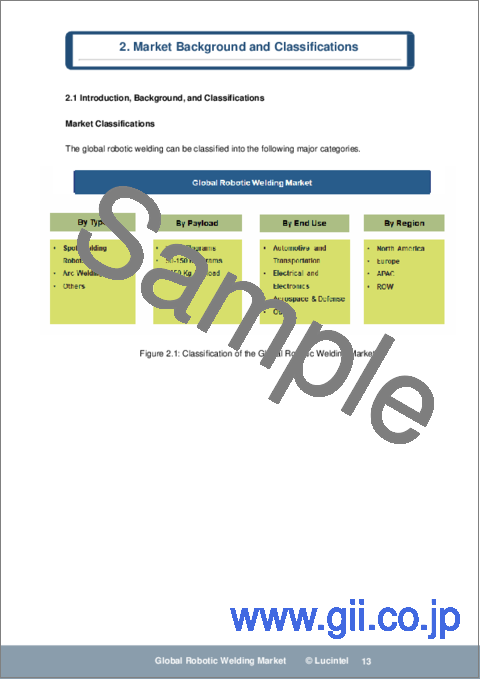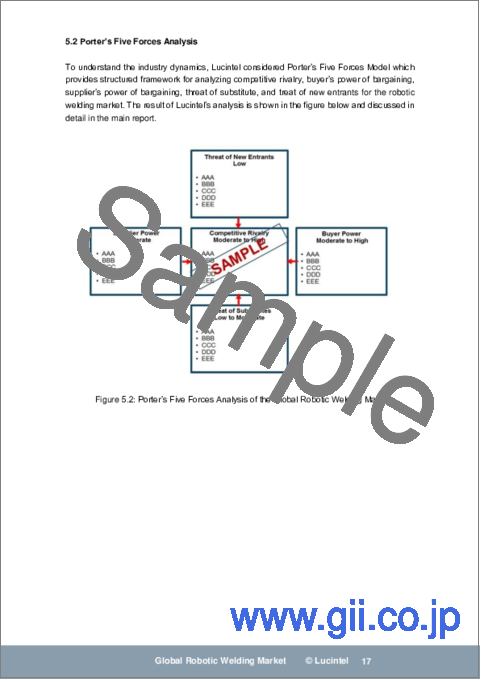|
|
市場調査レポート
商品コード
1417976
ロボット溶接市場レポート:2030年までの動向、予測、競合分析Robotic Welding Market Report: Trends, Forecast and Competitive Analysis to 2030 |
||||||
|
● お客様のご希望に応じて、既存データの加工や未掲載情報(例:国別セグメント)の追加などの対応が可能です。 詳細はお問い合わせください。 |
|||||||
| ロボット溶接市場レポート:2030年までの動向、予測、競合分析 |
|
出版日: 2024年01月29日
発行: Lucintel
ページ情報: 英文 150 - page report
納期: 3営業日
|
- 全表示
- 概要
- 目次
ロボット溶接の動向と予測
世界のロボット溶接市場は、2024年から2030年までのCAGRが10.2%で、2030年までに推定150億米ドルに達すると予測されています。この市場の主な促進要因は、インダストリー4.0の採用が拡大していることと、自動車および輸送産業における溶接ロボットの使用率が上昇していることです。世界のロボット溶接市場の将来は、自動車・運輸、電気・電子、航空宇宙・防衛の各市場における機会によって有望視されています。
ロボット溶接市場の洞察
Lucintelは、スポット溶接ロボットは、省スペース、重い機械の持ち上げ(溶接ガンや金属板を含む)、強く正確で高品質な溶接などの利点があるため、予測期間中、より大きなセグメントであり続けると予測しています。
この市場の中では、自動車製造が著しく成長しているため、自動車と輸送が最大のセグメントであり続けると思われます。
アジア太平洋は、中国、インド、日本などの国々で大規模な製造装置が存在し、工業化が進んでいるため、予測期間中も最大地域であり続けると思われます。
よくある質問
Q1.市場規模は?
A1.世界のロボット溶接市場は、2030年までに推定150億米ドルに達すると予想されています。
Q2.市場の成長予測は?
A2.世界のロボット溶接市場は、2024年から2030年にかけてCAGR 10.2%で成長すると予測されます。
Q3.市場の成長に影響を与える主な促進要因は?
A3.この市場の主な促進要因は、インダストリー4.0の採用拡大と、自動車および輸送産業における溶接ロボットの使用率の上昇です。
Q4.市場の主要セグメントは?
A4.ロボット溶接市場の将来は、自動車・運輸、電気・電子、航空宇宙・防衛の各市場における機会が有望です。
Q5.市場の主要企業は?
A5.ロボット溶接の主要企業は以下の通り。
- FANUC
- YASKAWA
- KUKA
- ABB
- Kawasaki Heavy Industries
Q6.今後、最大となる市場セグメントは?
A6.Lucintelは、スポット溶接ロボットが、低スペース要件、(溶接ガンや金属板を含む)重い機械の持ち上げ、強力で正確かつ高品質な溶接などの利点があるため、予測期間中、より大きなセグメントであり続けると予測しています。
Q7.市場において、今後5年間に最大になると予想される地域は?
A7.APACは、中国、インド、日本などの国々における大規模な製造ユニットの存在と工業化の進展により、予測期間中も最大地域であり続ける。
Q8.レポートのカスタマイズは可能?
A8.はい、Lucintelは追加費用なしで10%のカスタマイズを提供します。
目次
第1章 エグゼクティブサマリー
第2章 世界のロボット溶接市場:市場力学
- イントロダクション、背景、分類
- サプライチェーン
- 業界の促進要因と課題
第3章 2018年~2030年の市場動向と予測分析
- マクロ経済動向(2018年~2023年)と予測(2024年~2030年)
- 世界のロボット溶接市場動向(2018年~2023年)と予測(2024年~2030年)
- 世界のロボット溶接市場、タイプ別
- スポット溶接ロボット
- アーク溶接ロボット
- その他
- 世界のロボット溶接市場、ペイロード別
- 150キログラム以上
- 50~150キログラム
- 150キログラム以上
- 世界のロボット溶接市場、最終用途別
- 自動車・輸送
- 電気・電子
- 航空宇宙・防衛
- その他
第4章 2018年~2030年の地域別の市場動向と予測分析
- 地域別の世界のロボット溶接市場
- 北米のロボット溶接市場
- 欧州ロボット溶接市場
- アジア太平洋のロボット溶接市場
- その他地域のロボット溶接市場
第5章 競合の分析
- 製品ポートフォリオ分析
- 運用上の統合
- ポーターのファイブフォース分析
第6章 成長機会と戦略的分析
- 成長機会分析
- タイプ別の世界のロボット溶接市場の成長機会
- ペイロード別の世界のロボット溶接市場の成長機会
- 最終用途別の世界のロボット溶接市場の成長機会
- 地域別の世界のロボット溶接市場の成長機会
- 世界のロボット溶接市場の新たな動向
- 戦略的分析
- 新製品の開発
- 世界のロボット溶接市場の能力拡大
- 世界のロボット溶接市場における合併、買収、合弁事業
- 認証とライセンシング
第7章 有力企業の企業プロファイル
- FANUC
- YASKAWA
- KUKA
- ABB
- Kawasaki Heavy Industries
Robotic Welding Trends and Forecast
The future of the global robotic welding market looks promising with opportunities in the automotive and transportation, electrical and electronics, and aerospace & defense markets. The global robotic welding market is expected to reach an estimated $15 billion by 2030 with a CAGR of 10.2% from 2024 to 2030. The major drivers for this market are growing adoption of industry 4.0 and rising usage of welding robots in the automotive and transportation industries.
A more than 150-page report is developed to help in your business decisions.
Robotic Welding by Segment
The study includes a forecast for the global robotic welding by type, payload, end use, and region.
Robotic Welding Market by Type [Shipment Analysis by Value from 2018 to 2030]:
- Spot Welding Robots
- Arc Welding Robots
- Others
Robotic Welding Market by Payload [Shipment Analysis by Value from 2018 to 2030]:
- >150 Kilograms
- 50-150 Kilograms
- >150 Kg Payload
Robotic Welding Market by End Use [Shipment Analysis by Value from 2018 to 2030]:
- Automotive and Transportation
- Electrical and Electronics
- Aerospace & Defense
- Others
Robotic Welding Market by Region [Shipment Analysis by Value from 2018 to 2030]:
- North America
- Europe
- Asia Pacific
- The Rest of the World
List of Robotic Welding Companies
Companies in the market compete on the basis of product quality offered. Major players in this market focus on expanding their manufacturing facilities, R&D investments, infrastructural development, and leverage integration opportunities across the value chain. With these strategies robotic welding companies cater increasing demand, ensure competitive effectiveness, develop innovative products & technologies, reduce production costs, and expand their customer base. Some of the robotic welding companies profiled in this report include-
- FANUC
- YASKAWA
- KUKA
- ABB
- Kawasaki Heavy Industries
Robotic Welding Market Insights
Lucintel forecasts that spot welding robot will remain the larger segment over the forecast period due to its benefits, such as low-space requirements, heavy machine lifting (including welding guns and metal sheets), and strong, accurate, and high-quality welds.
Within this market, automotive and transportation will remain the largest segment due to significantly growing automobile manufacturing.
APAC will remain the largest region over the forecast period due to presence of large manufacturing units and growing industrialization in countries, such as China, India, and Japan.
Features of the Global Robotic Welding Market
Market Size Estimates: Robotic welding market size estimation in terms of value ($B).
Trend and Forecast Analysis: Market trends (2018 to 2023) and forecast (2024 to 2030) by various segments and regions.
Segmentation Analysis: Robotic welding market size by type, payload, end use, and region in terms of value ($B).
Regional Analysis: Robotic welding market breakdown by North America, Europe, Asia Pacific, and Rest of the World.
Growth Opportunities: Analysis of growth opportunities in different types, payloads, end use, and regions for the robotic welding market.
Strategic Analysis: This includes M&A, new product development, and competitive landscape of the robotic welding market.
Analysis of competitive intensity of the industry based on Porter's Five Forces model.
FAQ
Q1. What is the robotic welding market size?
Answer: The global robotic welding market is expected to reach an estimated $15 billion by 2030.
Q2. What is the growth forecast for robotic welding market?
Answer: The global robotic welding market is expected to grow with a CAGR of 10.2% from 2024 to 2030.
Q3. What are the major drivers influencing the growth of the robotic welding market?
Answer: The major drivers for this market are growing adoption of industry 4.0 and rising usage of welding robots in the automotive and transportation industries.
Q4. What are the major segments for robotic welding market?
Answer: The future of the robotic welding market looks promising with opportunities in the automotive and transportation, electrical and electronics, and aerospace & defense markets.
Q5. Who are the key robotic welding market companies?
Answer: Some of the key robotic welding companies are as follows.
- FANUC
- YASKAWA
- KUKA
- ABB
- Kawasaki Heavy Industries
Q6. Which robotic welding market segment will be the largest in future?
Answer: Lucintel forecasts that spot welding robot will remain the larger segment over the forecast period due to its benefits, such as low-space requirements, heavy machine lifting (including welding guns and metal sheets), and strong, accurate, and high-quality welds.
Q7. In robotic welding market, which region is expected to be the largest in next 5 years?
Answer: APAC will remain the largest region over the forecast period due to presence of large manufacturing units and growing industrialization in countries, such as China, India, and Japan.
Q.8 Do we receive customization in this report?
Answer: Yes, Lucintel provides 10% customization without any additional cost.
This report answers following 11 key questions:
- Q.1. What are some of the most promising, high-growth opportunities for the robotic welding market by type (spot welding robots, arc welding robots, and others), payload (>150 kilograms, 50-150 kilograms, and >150 kg payload), end use (automotive and transportation, electrical and electronics, aerospace & defense, and others), and region (North America, Europe, Asia Pacific, and the Rest of the World)?
- Q.2. Which segments will grow at a faster pace and why?
- Q.3. Which region will grow at a faster pace and why?
- Q.4. What are the key factors affecting market dynamics? What are the key challenges and business risks in this market?
- Q.5. What are the business risks and competitive threats in this market?
- Q.6. What are the emerging trends in this market and the reasons behind them?
- Q.7. What are some of the changing demands of customers in the market?
- Q.8. What are the new developments in the market? Which companies are leading these developments?
- Q.9. Who are the major players in this market? What strategic initiatives are key players pursuing for business growth?
- Q.10. What are some of the competing products in this market and how big of a threat do they pose for loss of market share by material or product substitution?
- Q.11. What M&A activity has occurred in the last 5 years and what has its impact been on the industry?
Table of Contents
1. Executive Summary
2. Global Robotic Welding Market : Market Dynamics
- 2.1: Introduction, Background, and Classifications
- 2.2: Supply Chain
- 2.3: Industry Drivers and Challenges
3. Market Trends and Forecast Analysis from 2018 to 2030
- 3.1. Macroeconomic Trends (2018-2023) and Forecast (2024-2030)
- 3.2. Global Robotic Welding Market Trends (2018-2023) and Forecast (2024-2030)
- 3.3: Global Robotic Welding Market by Type
- 3.3.1: Spot Welding Robots
- 3.3.2: Arc Welding Robots
- 3.3.3: Others
- 3.4: Global Robotic Welding Market by Payload
- 3.4.1: >150 kilograms
- 3.4.2: 50-150 kilograms
- 3.4.3: >150 kg Payload
- 3.5: Global Robotic Welding Market by End Use
- 3.5.1: Automotive and Transportation
- 3.5.2: Electrical and Electronics
- 3.5.3: Aerospace & Defense
- 3.5.4: Others
4. Market Trends and Forecast Analysis by Region from 2018 to 2030
- 4.1: Global Robotic Welding Market by Region
- 4.2: North American Robotic Welding Market
- 4.2.2: North American Robotic Welding Market by End Use: Automotive and Transportation, Electrical and Electronics, Aerospace & Defense, and Others
- 4.3: European Robotic Welding Market
- 4.3.1: European Robotic Welding Market by Type: Spot Welding Robots, Arc Welding Robots, and Others
- 4.3.2: European Robotic Welding Market by End Use: Automotive and Transportation, Electrical and Electronics, Aerospace & Defense, and Others
- 4.4: APAC Robotic Welding Market
- 4.4.1: APAC Robotic Welding Market by Type: Spot Welding Robots, Arc Welding Robots, and Others
- 4.4.2: APAC Robotic Welding Market by End Use: Automotive and Transportation, Electrical and Electronics, Aerospace & Defense, and Others
- 4.5: ROW Robotic Welding Market
- 4.5.1: ROW Robotic Welding Market by Type: Spot Welding Robots, Arc Welding Robots, and Others
- 4.5.2: ROW Robotic Welding Market by End Use: Automotive and Transportation, Electrical and Electronics, Aerospace & Defense, and Others
5. Competitor Analysis
- 5.1: Product Portfolio Analysis
- 5.2: Operational Integration
- 5.3: Porter's Five Forces Analysis
6. Growth Opportunities and Strategic Analysis
- 6.1: Growth Opportunity Analysis
- 6.1.1: Growth Opportunities for the Global Robotic Welding Market by Type
- 6.1.2: Growth Opportunities for the Global Robotic Welding Market by Payload
- 6.1.3: Growth Opportunities for the Global Robotic Welding Market by End Use
- 6.1.4: Growth Opportunities for the Global Robotic Welding Market by Region
- 6.2: Emerging Trends in the Global Robotic Welding Market
- 6.3: Strategic Analysis
- 6.3.1: New Product Development
- 6.3.2: Capacity Expansion of the Global Robotic Welding Market
- 6.3.3: Mergers, Acquisitions, and Joint Ventures in the Global Robotic Welding Market
- 6.3.4: Certification and Licensing
7. Company Profiles of Leading Players
- 7.1: FANUC
- 7.2: YASKAWA
- 7.3: KUKA
- 7.4: ABB
- 7.5: Kawasaki Heavy Industries




